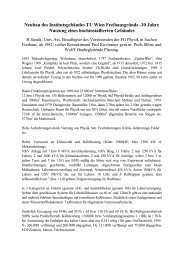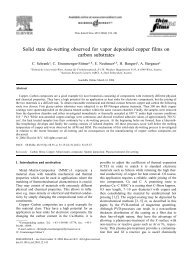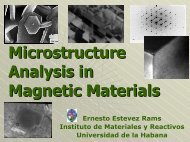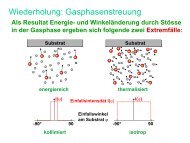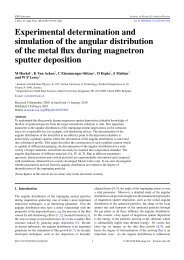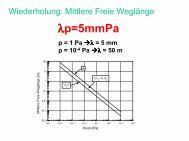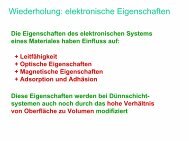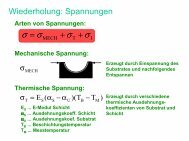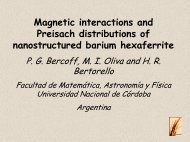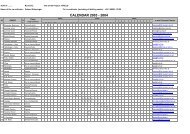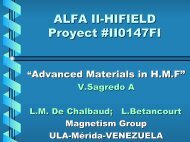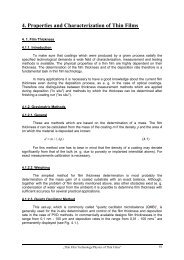Extended X-ray absorption fine structure (EXAFS) - Technische ...
Extended X-ray absorption fine structure (EXAFS) - Technische ...
Extended X-ray absorption fine structure (EXAFS) - Technische ...
Create successful ePaper yourself
Turn your PDF publications into a flip-book with our unique Google optimized e-Paper software.
ARTICLE IN PRESS<br />
Journal of Magnetism and Magnetic Materials 320 (2008) e578–e582<br />
www.elsevier.com/locate/jmmm<br />
<strong>Extended</strong> X-<strong>ray</strong> <strong>absorption</strong> <strong>fine</strong> <strong>structure</strong> (<strong>EXAFS</strong>) and<br />
X-<strong>ray</strong> <strong>absorption</strong> near-edge <strong>structure</strong> (XANES) study<br />
of melt-spun Fe 85 Ga 15 ribbons<br />
R. Sato Turtelli a, , S. Pascarelli b , M. Ruffoni b , R. Gro¨ssinger a , C. Eisenmenger-Sittner a<br />
a Institut f. Festkörperphysik, <strong>Technische</strong> Universität Wien, Wiedner Haupts. 8-10, A-1040 Vienna, Austria<br />
b European Synchroton Radiation Facility, BP 220, 38043 Grenoble, Cedex, France<br />
Available online 10 April 2008<br />
Abstract<br />
The local <strong>structure</strong> in melt-spun Fe 85 Ga 15 ribbons with a width 3 mm and thickness 60 mm produced in argon atmosphere was<br />
studied by analyzing <strong>EXAFS</strong> and XANES data. The following results were obtained: Ga–Ga bonds were not detected excluding the<br />
tendency to form clusters of Ga atoms; Ga substitutes Fe creating a local strain of about +1% on the first shell Fe–Ga bond, whereas on<br />
the second Fe–Ga shell strain quickly relaxes down to +0.3%; XANES spectra are compatible with a random substitution of Fe atoms<br />
by Ga atoms in the A2 <strong>structure</strong>. From the AFM investigation, we observed that at the surface (free side) of the ribbon the particles are<br />
elongated along the ribbon (2 mm 5 mm) and each particle is formed by small grains of average size of 200 nm.<br />
r 2008 Elsevier B.V. All rights reserved.<br />
PACS: 75.50.Bb; 75.80.+q; 61.10.Ht<br />
Keywords: Fe–Ga alloy; Magnetostriction; <strong>EXAFS</strong>; XANES<br />
1. Introduction<br />
Fe–Ga alloys can provide low-cost magnetostricitve<br />
materials with high mechanical strength, good ductility,<br />
large magnetostrictive at low saturation fields with<br />
negligible magnetostrictive hysteresis and attractive magnetic<br />
properties to be used in acoustic sensors and<br />
actuators. The large magnetostriction of Fe–Ga alloys<br />
depends strongly on sample production methods and<br />
thermal history, which result in different crystallographic<br />
texture and grain morphology [1–5]. Single crystal [1 0 0]<br />
oriented Fe 100 x Ga x alloys, where 13pxp23, can exhibit<br />
magnetostriction in the l 100 direction of up to 270 ppm [3].<br />
Ductility of Fe–Ga alloys has been largely improved by the<br />
melt-spun method, producing ribbons. In addition, thin<br />
ribbon sample minimizes ac-eddy current losses and be well<br />
suited for working at high frequency. However, reports of<br />
Corresponding author. Tel.: +43 1 58801 13150;<br />
fax: +43 1 58801 13199.<br />
E-mail address: reiko.sato@ifp.tuwien.ac.at (R. Sato Turtelli).<br />
different magnetostriction values in the literature, for<br />
similar compositions, are not uncommon. These include a<br />
value of 130 ppm in strained ribbons of Fe 83 Ga 17 [6], a<br />
giant magnetostriction up to 1300 ppm in stacked ribbons<br />
of Fe 85 Ga 15 [7], and a value of 3000 ppm in annealed<br />
Fe 81 Ga 19 ribbons [8]. Some reported values are larger than<br />
that of Terfenol-D.<br />
The enhancement of magnetostriction in melt-spun<br />
samples has been attributed to a change in local <strong>structure</strong><br />
due to the melt spinning method itself, and also to the<br />
short-range preferential ordering of Ga atoms in the [0 0 1]<br />
direction, which supposedly form clusters. However,<br />
different researchers have reported contradicting results<br />
of crystallographic phases. For melt-spun Fe–Ga alloys<br />
with Ga contents lower than 21 at%, Ref. [6] reports the<br />
existence of only a disordered A2 phase, while Ress. [7,9]<br />
report the appearance of a D0 3 <strong>structure</strong>. In order to<br />
understand these different results in similar ribbons, more<br />
micro<strong>structure</strong> and local <strong>structure</strong> investigations are<br />
necessary. Therefore in this work, the local <strong>structure</strong> of a<br />
melt-spun Fe 85 Ga 15 ribbon with a width 3 mm and<br />
0304-8853/$ - see front matter r 2008 Elsevier B.V. All rights reserved.<br />
doi:10.1016/j.jmmm.2008.04.036
thickness 60 mm was produced in an argon atmosphere<br />
and was studied by analyzing extended X-<strong>ray</strong> <strong>absorption</strong><br />
<strong>fine</strong> <strong>structure</strong> (<strong>EXAFS</strong>) and X-<strong>ray</strong> <strong>absorption</strong> near-edge<br />
<strong>structure</strong> (XANES) data. Additionally a Topometrix<br />
‘‘Explorer’’ atomic force microscope (AFM) was used to<br />
investigate the grain <strong>structure</strong> of the ribbon.<br />
ARTICLE IN PRESS<br />
R. Sato Turtelli et al. / Journal of Magnetism and Magnetic Materials 320 (2008) e578–e582 e579<br />
2. Experimental procedure<br />
An ingot of Fe 80 Ga 15 alloy with high purity (499.9%)<br />
was prepared by arc melting. Ejecting the melt onto a<br />
rotating copper wheel produced a rapidly quenched ribbon<br />
with a thickness of 50 mm and width of 3 mm. From the<br />
energy dispersive X-<strong>ray</strong> analysis, the as-quenched ribbon<br />
exhibits a composition similar to that of the ingot.<br />
The grain <strong>structure</strong> of the ribbon was investigated by<br />
means of a Topometrix ‘‘Explorer’’ AFM with a Si3N4 tip<br />
mounted on a cantilever of spring constant 0.3 N/m. Local<br />
structural investigations were performed on a thin sample,<br />
7 mm thick, obtained by polishing both the wheel and free<br />
sides of the ribbon. <strong>EXAFS</strong> spectra were recorded at the Fe<br />
and Ga K-edges at beam line BM29 of the European<br />
synchrotron radiation facility (ESRF). A 4 mm thick highpurity<br />
Fe foil (from Goodfellow) was used as a standard.<br />
3. Results and discussions<br />
Fig. 1 shows AFM pictures obtained on the wheel side of<br />
the Fe 85 Ga 15 ribbon. As can be seen in the upper picture,<br />
the grains are elongated along the direction of the ribbon<br />
with an average grain size of 2–3 by 5–10 mm. It is<br />
interesting to note that each grain is composed of <strong>fine</strong><br />
elongated particles around 200 nm in the direction of the<br />
thickness of the ribbon. This kind of small particle also<br />
exists in melt-spun Fe 80 Ga 20 samples [10]. The grain size<br />
determined by X-<strong>ray</strong> diffraction is of same order of<br />
magnitude and presents a texture [10]. As magnetostriction<br />
depends strongly of structural properties of grains (such as<br />
shape and texture [1–5]), magnetostriction measurements in<br />
each direction may result in different values.<br />
X-<strong>ray</strong> <strong>absorption</strong> <strong>fine</strong> <strong>structure</strong> (XAFS) spectroscopy is<br />
particularly suited to probe the local environment of the<br />
absorber atom. We have independently analyzed the<br />
extended <strong>fine</strong> <strong>structure</strong> region of the spectra (or <strong>EXAFS</strong>),<br />
and the near-edge (or XANES) region. The former,<br />
characterized by relatively large photoelectron energy<br />
(450 eV) with a relatively low mean free path, can be<br />
interpreted in a simplified manner using a single-scattering<br />
formalism, whereby the emitted photoelectron wave is<br />
scattered once by the electronic potentials of the neighboring<br />
atoms. The latter, where the photoelectron energy<br />
is low with a large mean free path, arises from complex<br />
multiple scattering processes and its interpretation<br />
is difficult because details in the description of the<br />
potentials cannot be neglected so easily as can be done in<br />
<strong>EXAFS</strong> region.<br />
Fig. 1. AFM pictures obtained on the wheal side of the Fe 85 Ga 15 ribbon.<br />
Up: sensor picture; bottom: topography picture with high amplification.<br />
Consequently, <strong>EXAFS</strong> is very sensitive to the first<br />
neighbor shells and can yield information on the chemical<br />
nature of the nearest neighbors, their number, distance<br />
from the absorber atom and thermal and static disorder<br />
relative to the absorber atom. XANES, on the other hand,<br />
is very sensitive to the local bonding geometry and<br />
electronic <strong>structure</strong>.<br />
We based our <strong>EXAFS</strong> analysis on a structural model<br />
obtained from crystallographic data [4], which found that<br />
Fe 85 Ga 15 ribbons crystallize in the A2 phase [bcc phase]<br />
with lattice parameter a 0 ¼ 2.900 A˚ . Based on these input<br />
structural parameters, we built atomic clusters (one<br />
centered on Fe and one centered on Ga) for the <strong>EXAFS</strong><br />
simulations. Due to the short-range sensitivity of the<br />
<strong>EXAFS</strong> probe, we considered only the region of R-space<br />
that extends up to about 3 A˚ from the absorber, i.e. the first<br />
two coordination shells of the bcc lattice. The software<br />
package FEFF8.2 [11] was used to calculate ab initio<br />
scattering phases and amplitudes for a Fe and a Ga<br />
absorber using the atomic clusters de<strong>fine</strong>d above, and
e580<br />
ARTICLE IN PRESS<br />
R. Sato Turtelli et al. / Journal of Magnetism and Magnetic Materials 320 (2008) e578–e582<br />
simulated the <strong>EXAFS</strong> signal using a high-order path<br />
expansion.<br />
For the Fe6¼K-edge we considered the following: (i) a<br />
first coordination shell composed of a total of N Fe +<br />
N Ga ¼ 8 atoms, with an unknown x ¼ N Ga /(N Fe +N Ga ).<br />
The bond distances and mean square relative displacements<br />
(msrd) of Fe–Fe and Fe–Ga are unknown; (ii) a second<br />
shell composed, in a first approximation, of 6 Fe atoms at<br />
an unknown distance (linked through crystallographic<br />
constrains to the first shell Fe–Fe distance) and msrd. As<br />
a second step, the presence of some Ga was also considered<br />
in the second shell, but we did not have sufficient sensitivity<br />
to confirm the number of Ga atoms in this shell.<br />
For the Ga K-edge both the first and second shell are<br />
composed of only Fe atoms (8+6) at an unknown<br />
distance. The presence of Ga in the first shell was tested<br />
and was excluded in this analysis.<br />
The only paths contributing to the <strong>EXAFS</strong> signal in the<br />
R-range up to 3 A˚ are the two single scattering (SS) paths<br />
corresponding to the first (total path length 2R 1 ) and<br />
second shell (total path length 2R 2 ). Fig. 2 illustrates the<br />
results of ab initio calculations for the first shell SS paths,<br />
plotted as a function of photoelectron wavevector k. These<br />
signals show that, besides a small and almost constant<br />
phase shift, the scattering amplitudes of Ga and Fe differ<br />
mainly in the low k region.<br />
Fig. 3 shows the normalized <strong>EXAFS</strong> spectra obtained on<br />
the Fe 85 Ga 15 ribbon at the Fe and Ga K-edges, respectively.<br />
The Fe K-edge <strong>EXAFS</strong> on a pure Fe foil standard is<br />
also shown.<br />
By comparing the Fe K-edge <strong>EXAFS</strong> oscillations of the<br />
Ga-containing sample to that of pure Fe foil, besides a<br />
reduction in amplitude, there is also a small change in the<br />
shape of the first oscillations, at k3–4 A˚ . The difference in<br />
calculated signals<br />
0.5<br />
0.4<br />
0.3<br />
0.2<br />
0.1<br />
0<br />
-0.1<br />
-0.2<br />
4<br />
k (A -1 )<br />
Ga-Fe<br />
Ga-Ga<br />
Fe-Fe<br />
Fe-Ga<br />
6 8 10 12 14<br />
Fig. 2. Ab initio calculations for the first shell SS paths: Blue curve: Fe<br />
(absorber)–Fe (scatterer). Red curve: Ga(absorber)–Ga (Scatterer).<br />
<strong>EXAFS</strong> χ(k)<br />
0.4<br />
0.3<br />
0.2<br />
0.1<br />
0<br />
-0.1<br />
-0.2<br />
-0.3<br />
-0.4<br />
4<br />
Fe 85 Ga 15 Fe K-edge<br />
k (A -1 )<br />
the shape of the Fe K-edge <strong>EXAFS</strong> between the sample<br />
and pure Fe at low k values, seen in Fig. 3, is likely to be<br />
attributed to the detection of Ga in the first coordination<br />
shell.<br />
In order to extract the local structural parameters (bond<br />
distance, R, msrd, Ds 2 , and ratio between Ga/Fe scatters,<br />
x, we performed a least-square fitting of the first peak of<br />
the Fourier transform (FT) of the <strong>EXAFS</strong> signals, where<br />
the FT was performed in the range 2.6pkp15.0 A˚ 1 .<br />
Using the calculated phases and amplitudes, we constructed<br />
a model <strong>EXAFS</strong> signal as the sum of two SS paths<br />
(first and second shell) with variable fitting parameters for<br />
energy offsets, bond distances and msrds for two shells,<br />
and chemical composition of the first shell. The Fe and Ga<br />
K-edges data were fitted simultaneously. A more detailed<br />
description of the fitting is given elsewhere [10].<br />
Fig. 4 shows the results of the best fits at the Fe and Ga<br />
edges for the Fe 85 Ga 15 ribbon and the standard Fe foil.<br />
The structural parameters obtained from the best fits are<br />
consistent with a picture whereby Ga substitutes Fe atoms<br />
randomly, creating local strain. The obtained value of the<br />
Fe–Ga bond is 2.52 A˚ , whereas the Fe–Fe bond is<br />
2.50 A˚ , implying a +1% expansion. On the second shell,<br />
strain quickly relaxes down to +0.3%, since we find<br />
Fe–Ga bonds of 2.89–2.90 A˚ and Fe–Fe bonds of<br />
2.88–2.89 A˚ . From Ga edge data we can conclude that<br />
no clustering occurs since we do not detect any Ga–Ga first<br />
shell bonds. We also performed fits at the Fe K-edge with a<br />
second shell Fe–Ga contribution of R Fe Ga and Ds 2 Fe Ga,<br />
equal to Ga K-edge values. However, these additional<br />
parameters did not improve the quality of the fits.<br />
To simulate the X-<strong>ray</strong> <strong>absorption</strong> near-edge <strong>structure</strong><br />
region of the spectra at the Fe and Ga K-edges, we again<br />
Fe<br />
Fe 85 Ga 15 Ga K-edge<br />
6 8 10 12 14<br />
Fig. 3. <strong>EXAFS</strong> oscillations plotted as function of photoelectron<br />
wavevector k.
ARTICLE IN PRESS<br />
R. Sato Turtelli et al. / Journal of Magnetism and Magnetic Materials 320 (2008) e578–e582 e581<br />
kχ(k)<br />
1.5<br />
1<br />
0.5<br />
0<br />
-0.5<br />
4<br />
k (A -1 )<br />
Ga K-edge<br />
Fe K-edge<br />
Fe 85 Ga 15<br />
Fe 85 Ga 15<br />
Fe<br />
6 8 10 12 14<br />
Fig. 4. Best fits for the Ga K-edge data on Fe 80 Ga 15 (top) and at the Fe<br />
K-edges on Fe 80 Ga 15 and pure Fe foil (bottom).<br />
All scattering paths within the same atomic cluster<br />
(approximately 60 atoms) were summed to infinite order.<br />
The imaginary part of the potential was not optimized<br />
and our simulations underestimate this damping at the<br />
<strong>absorption</strong> edge. Moreover, no disorder factor was<br />
introduced in the calculations, so that the high-energy <strong>fine</strong><br />
<strong>structure</strong> is also under-damped in the simulations, compared<br />
to the experimental data.<br />
The Fe K-edge simulations were done for (i) the pure Fe<br />
bcc phase (a ¼ 2.87 A˚ ); (ii) the A2 phase (a ¼ 2.90 A˚ )<br />
where 9 Fe atoms out of 59 (about 15%) have been<br />
substituted by Ga and (iii) the DO3 Fe 3 Ga phase<br />
(a ¼ 2.90 A˚ ); and Ga K-edge simulations (see Fig. 5) for<br />
(i) A2 phase where Ga is surrounded only by Fe atoms<br />
(‘‘Ga impurity x-40’’) (ii) the A2 phase where Ga is<br />
surrounded by Fe and 15% Ga randomly distributed (‘‘Ga<br />
impurity x0.15’’) (iii) the A2 phase where Ga is<br />
surrounded only by Ga in the first shell (‘‘Ga cluster’’),<br />
and by Fe in further shell and (iv) the DO3 Fe 3 Ga phase.<br />
A qualitative comparison of our XANES data with ab<br />
initio simulations indicates that all the observed features<br />
are reproduced by the A2 model, therefore the DO3 phase<br />
and clustering of Ga can be excluded.<br />
2<br />
4. Conclusions<br />
<strong>absorption</strong><br />
1.5<br />
1<br />
0.5<br />
0<br />
-0.5<br />
-1<br />
-1.5<br />
-2<br />
10.36<br />
D03<br />
A2 (Ga cluster)<br />
A2 (x ~ 0.15)<br />
A2 (x-> 0)<br />
experimental data<br />
10.38 10.4 10.42 10.44<br />
Energy (keV)<br />
(i) <strong>EXAFS</strong>: (a) No Ga–Ga bonds are detected, excluding<br />
the tendency to form clusters of Ga atoms; (b) Ga<br />
substitutes Fe, creating a local strain of about +1%<br />
on the first shell Fe–Ga bond. On the second Fe–Ga<br />
shell, strain quickly relaxes down to +0.3%.<br />
(ii) XANES: (a) the spectra are compatible with a random<br />
substitution of Fe atoms by Ga atoms in the A2<br />
<strong>structure</strong>; (b) the presence of Ga clusters or of a D0 3<br />
local environment around Ga has been tested and<br />
excluded.<br />
(iii) AFM: (a) the particles observed at the surface (wheel<br />
side) of the ribbon are elongated (width 3 mm, length<br />
5–10 mm) along the ribbon; (b) these particles are<br />
formed by <strong>fine</strong> grains elongated perpendicular to the<br />
surface of the ribbon with average width size of<br />
200 nm.<br />
Fig. 5. Ab initio full multiple scattering simulations of Ga K-edge data.<br />
The following models are used for the local environment of Ga, from top<br />
to bottom: the D03 phase, the A2 phase with only Ga surrounding Ga in<br />
the first shell (Ga cluster), the A2 phase where the first shell around Ga is<br />
composed of Fe atoms, and some Ga (x0.15) distributed randomly, the<br />
A2 phase where Ga is surrounded only by Fe atoms (x-40). The bottom<br />
curve is the experimental data.<br />
used FEFF8.2, but this time to perform full multiple<br />
scattering calculations. Ab initio scattering amplitudes and<br />
phases were calculated using complex Hedin-Lundvquist<br />
potentials, with the electronic density calculated selfconsistently<br />
within a radius of 5.5 A˚ from the absorber.<br />
References<br />
[1] A.E. Clark, M. Wun-Fogle, J.B. Restorff, T.A. Lograsso,<br />
J.R. Cullen, IEEE Trans. Magn. 37 (2001) 2678.<br />
[2] N. Srisukhumbowornchai, S. Guruswany, J. Appl. Phys. 90 (2001)<br />
5680.<br />
[3] A.E. Clark, K.B. Hathaway, M. Wun-Fogle, J.B. Restorff,<br />
T.A. Lagrasso, V.M. Keppens, G. Petculescu, R.A. Taylor, J. Appl.<br />
Phys. 93 (2003) 8621.<br />
[4] C. Bormio-Nunes, R. Sato Turtelli, R. Grössinger, H. Mu¨ller,<br />
G. Wiesinger, H. Sassik, M. Reissner, M.A. Tirelli, J. Appl. Phys. 97<br />
(2005) 033901.<br />
[5] R. Sato Turtelli, C. Bormio-Numes, J.P. Sinnecker, R. Gro¨ssinger,<br />
Phyisica B 384 (2006) 265.
e582<br />
ARTICLE IN PRESS<br />
R. Sato Turtelli et al. / Journal of Magnetism and Magnetic Materials 320 (2008) e578–e582<br />
[6] S.F. Cheng, B.N. Das, M. Wun-Fogle, P. Lubitz, A.E. Clark, IEEE<br />
Trans. Magn. 38 (2002) 2838.<br />
[7] G.D. Liu, L.B. Liu, Z.H. Liu, M. Zhang, J.L. Chen, J.Q. Li, G.H.<br />
Wu, Y.X. Li, J.P. Qu, T.S. Chin, Appl. Phys. Letters 84 (2004) 2124.<br />
[8] M.C. Zhang, X.X. Gao, H.L. Jiang, Y. Qiao, S.Z. Zhou, J. Alloys<br />
Comp. 431 (2007) 42.<br />
[9] M.C. Zhang, H.L. Jiang, X.X. Gao, J. Zhu, S.Z. Zhou, J. Appl. Phys.<br />
99 (2006) 023903.<br />
[10] S. Pascarelli, M. Ruffoni,R. Sato Turtelli, F. Kubel, R. Gro¨ssinger,<br />
Phys. Rev. B, in print.<br />
[11] S. Pascarelli, G. Aquilanti, W. Crichton, T. Le Bihan, M. Mezouar,<br />
S. De Panfilis, J.P. Itié, A. Polian, Europhys. Lett. 61 (2003) 554.



